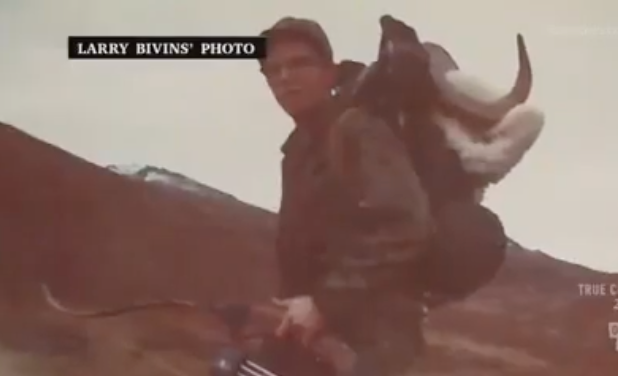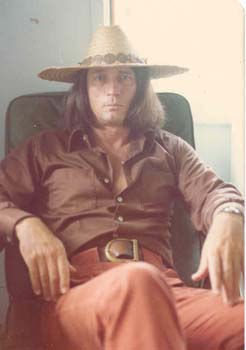
In the 1924 short story “The Most Dangerous Game,” author Richard Connell recounts the tale of a wealthy Russian aristocrat who, bored with trapping animals, lures a big-game hunter to his island and hunts him for sport.
Ever since the story was published, the perverse idea of humans hunting humans has captivated people. The disturbing concept has appeared time and again in the plots of novels, TV shows, and movies, but for the most part, it has been relegated to the pages of fiction.
However, according to the official narrative, in the 1970s, Robert Hansen, known as the “Butcher Baker,” turned this premise into a horrifying, decade-long reality. Though Hansen maintained a wholesome reputation in town, he let his hidden dark side run wild in the woods of Alaska.
Throughout the ’1970s and early ’1980s, Hansen targeted sex workers and exotic dancers, abducting these women to turn them loose in the woods so he could hunt them like animals.
Unlike his fictional counterpart, Robert Hansen was no aristocratic nobleman. Born on February 15, 1939, in Estherville, Iowa, his father was a Danish immigrant who owned a bakery. He was also a strict disciplinarian.
Hansen’s childhood was not an easy one. He worked long hours in the family bakery from a young age. Though he was naturally left-handed, he was forced to use his right hand instead, a switch that resulted in a lifelong stutter.
As a teenager he was painfully shy, had bad acne, and was mocked for his stutter. The boys at school made fun of him, and the girls he liked rejected him. He was often described as a loner.
As a social outcast, he took refuge in time spent alone. Over time, he became an avid game hunter, channeling his rage and fantasies of vengeance into the sport of stalking animals.

'After graduation in 1957, Hansen joined the Army Reserves and underwent basic training at Fort Dix, New Jersey.
One weekend he was randomly selected as the USO's Soldier of the Week, which earned him an expense-paid trip to New York City. There he teamed up with another young soldier and sought out a pair of prostitutes. The soldiers found the whores disinterested in the liaisons, and the encounters to be perfunctory and unsatisfying.
Hansen received advanced training as a military police officer at Fort Knox, Kentucky, and frequently visited prostitutes in the nearby community. He later told an interviewer "it was strictly slam, bam, thank you ma'am." He was dissatisfied with quickie sex and yearned to "take control of the situation."
After military training, he returned to Iowa and his father's bakery.
He also became later an assistant drill instructor in Pocahontas, Iowa, and even married a young woman he met there.

She was the daughter of the town's chiropractor. The girl came from a family as reclusive as his own. That same year the town of Pocahontas formed a Junior Police. Thirty young people were sworn in and the chief of police introduced their drill instructor, Robert Hansen. Shortly afterward Robert’s father hired the son of a jeweler to help out in the bakery. The boy was a quiet, crew-cut sixteen-year-old, someone Robert felt he could control.
But Hansen still felt mistreated by the community and sought retaliation. In 1960, at age 21, he convinced the young bakery employee to help him burn down a school bus garage. When the boy later confessed, Hansen was arrested. Among those manning the hoses that night was volunteer fireman Robert Hansen. His wife later divorced him, leaving him alone and incarcerated.
Though he was released just 20 months into his three-year sentence for arson, he was jailed a few more times afterward for petty theft. Still, he managed to remarry, to another local woman.

Finally, Hansen decided he’d had enough of the contiguous United States. In 1967 he moved to Anchorage, Alaska, which was about as far from his life in Iowa as he could get. He moved into a small community, had two children with his wife, and settled into a quiet life. He was well-liked and opened up a small bakery.

In the mountains around Anchorage, Hansen honed his skills as a hunter, and in 1969, 1970 and 1971, had 4 animals entered into the Pope and Young record book. He gained much attention one year when he brought down a Dahl sheep with his bow and arrow.


Anchorage was a thriving place in the 1970s. The pipeline boom was in full swing and money flowed, swelling the city's population and bringing new opportunity. Those thronging north included young men and women looking for new lives, adventure, and a chance to make money. Among them were entrepreneurs of all kinds, everything from oil and real estate speculators to mobsters, some in hard hats, some in business suits.'

Racketeers were invisible at first. Fourth Avenue had been the center of the city's seamy side since the boom days of World War II and remained unchanged through the discovery of oil at Swanson River on the Kenai Peninsula in 1957 and the heady days of statehood that followed. Boom times came and fell away, but Alaska always grew, only the pace changing. And always, through good times and bad, bored and lonely people gathered on Fourth Avenue in search of a good time.

The avenue was called the longest bar in the world. It was home to row on row of taverns, close enough to allow continuous bar hopping without fighting the weather. In the 1970s, Fourth Avenue drew nude dancers, prostitutes, and the hard-drinking men who were flooding in to build the pipeline and get in on the action.

Many of the establishments were owned or controlled by Frank Colacurcio, a Seattle mobster who ran a topless bar and pornography network from his cell at the McNeil Island federal penitentiary in Puget Sound, Washington. His Alaska clubs—and most of the few independents remaining in Anchorage—hired young women through Talents West, a Colacurcio-owned booking agency.'

The women of Fourth Avenue lived a high-risk lifestyle.
Anchorage at the time had an extremely rough "tenderloin" district. It was a wide-open district centered on Fourth Avenue where anything went. Young women were lured there by promises of making huge wages 'dancing' in clubs with names like Wild Cherry, Arctic Fox, Booby Trap and the Great Alaskan Bush Company (which is still in operation, though in a different location). As the population and disposable income skyrocketed in Anchorage during the oil boom, the bigger clubs were skimming off $50-100,000 a month in cash. Between the clubs were peep shows, and magazine stands featuring the worst kind of child pornography. Also part of that world was violence - from beatings and armed robberies to firebombs and murders, police were kept busy. Between 1979 and 1983, police responded 207 times to disturbances at the Booby Trap alone.
In 1972, Hansen was arrested twice: once for the abduction and attempted rape of a housewife, and again for raping a prostitute. Unknown to authorities, his killing spree began in 1973, likely emboldened by his ability to walk free after those early rapes.

The year of 1976 saw Hansen arrested again and sentenced to five years for shoplifting a chainsaw. He underwent psychiatric testing and was diagnosed as having bipolar disorder. Doctors prescribed a Lithium program to control his mood swings, and ordered him to remain on it even after his release. However, he appealed the sentence and was released.
In the early 1980’s, Bob reported that someone had broken into his house and stole several of his hunting trophies, along with jewelry and electronics. The break-in netted him $13,000 in insurance claim money, and he used this to buy his own bakery in downtown Anchorage.





When he was arrested, Detectives found a "soundproof room’’ in the Hansen household.
In July 1982 he used bakery cash and an insurance settlement to buy a small airplane, a SuperCub, ideal for wilderness flying. He did not have a pilot's license; he was refused one because he was taking lithium. But Hansen learned to fly illicitly. He became a skilled if illegal pilot.

In 1983, more than a decade after Hansen moved to Anchorage, a 17-year-old girl named Cindy Paulson was found running frantically down Sixth Avenue, barefoot and handcuffed.

After being picked up by a driver and returned to safety, Paulson, a prostitute, told her story to police. She described being held hostage by a man who’d handcuffed her to his car, held her at gunpoint, and took her to his house where he chained her by the neck.
The man raped and tortured her repeatedly, before attempting to load her onto a plane and take her to his cabin in the Matanuska-Susitna Valley about 35 miles north of Anchorage. As the man prepared the plane for takeoff, Paulson managed to escape, leaving her shoes behind as evidence.
Hansen fit the description of the kidnapper perfectly. Paulson even described his stutter and identified his plane. But police were still reluctant to bring him in. After all, though he was no stranger to trouble with the law, the local baker was well-liked in the community.

Hansen admitted that he had met the girl but claimed she was setting him up because he had refused to pay her extortionate demands.
He also told them he had an alibi — he was with friends that night and they’d vouch for him. When A.P.D. Officer Dennis called John Henning, one of those alibi witnesses, Henning confirmed that Bob Hansen was at his house from about 11:30 p.m. until 5:00 in the morning. They talked about fishing and ate pizza, Henning said.
Because Hansen had another alibi witness, John Sumrall, who said Hansen had been with him from 5:00 p.m. until 11:30 p.m., fixing an airplane seat, the cops took it to mean that Cindy Paulson’s complaint had been fabricated.
The cops believed Hansen’s friends, not some teen-aged prostitute.
John Sumrall was an insurance company executive at Allstate.
Persons of interest: Hansen's family minister, the Rev. Albert L. Abrahamson, pastor of Lutheran Central Church; and two hunting buddies, John Sumrall and Gerald Goldschmidt, an environmental health officer for the Alaska Native Health Service.
Hansen told some prostitutes he had friends in ''high places''.
When police was closing in on Hansen his friends John Sumrall and John Henning recanted their testimony.



Faced with the evidence in 1984, Hansen confessed to murdering 17 women and raping another 30 women over a 12-year period.



Hansen was sentenced to 461 years plus life in prison without parole in 1984. He was imprisoned at Spring Creek Correctional Center in Seward, Alaska, where he died in 2014.
As part of a plea bargain, the “Butcher Baker” was only ever charged with four of the 17 murders he confessed too.


Robert Hansen repeatedly stated I cooperate (the confession) because: ''I want to minimize the impact on my wife and children.’’ (Former Colonel Russell Williams stated the exact same thing)

According to this website/blog - Victim Andrea Altiery was before her dead connected with the Chuck Hawkins Cult. A criminally destructive mind control cult in Kona, Hawaii. Andrea Altiery, was the daughter of then Hawaii state senator Mason Altiery (Altieri).

http://www.missmanagement.com/Commune/CommunePages/CultNightmare.html









FBI Records: The Vault https://vault.fbi.gov/robert-hansen/robert-hansen-part-01-final/view